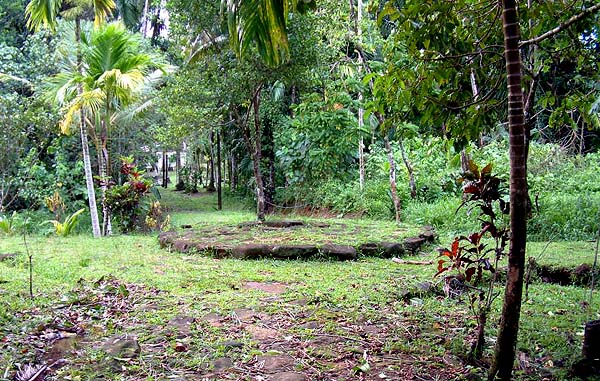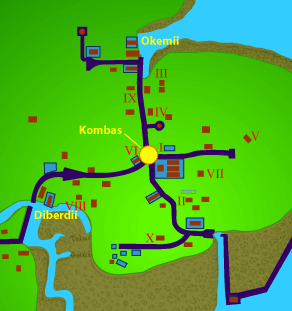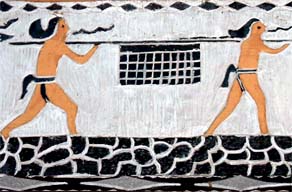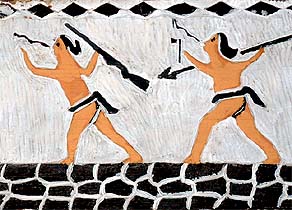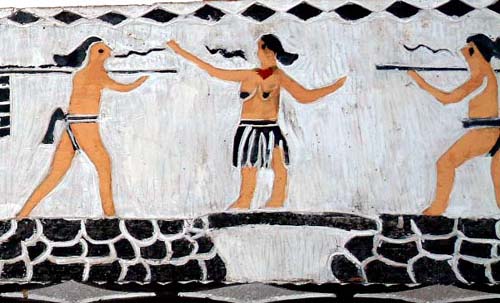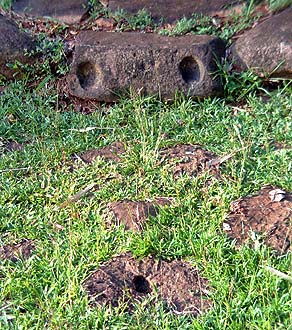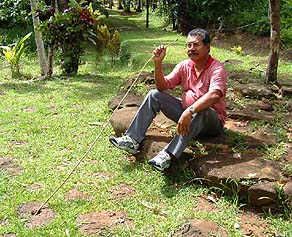 |
 |
 |
 |
||||
|
|
|
|
|
|
|
|
|
|
|
|||||||
|
|
|
|
Kombas sits at the junction of the four pathways.
|
|
"This is sort of like the town square over here now," Walter says. "Recently it is called Kombas. But I am sure Kramer’s map doesn’t show this one. So I think this is recently made, maybe during that period and after, when they re-paved and changed the shape of the road here. And they say it’s called ‘Kombas’ but probably that came from the Western word ‘compass'. One of the names for it is Bdelulacharauldekel." The B in "Kombas" is pronounced like a p, so it sounds very much like "compass."
|
||
| |
||
| “This place is also appears on the tie beams in the bai: the story of the role that this village played in the history of Palau, between the Ibedul side of Palau and the Reklai side. This is where the two got together. There be a women here, to stop the rebelling villages in here, and then they would start the big feast over here. She would make peace between the two parts of Babeldaob. “In the stories at the bai it shows this culvert over here, and there was a big slab that was bridging it, and this is where the women was standing when the Koror side and the Reklai side were coming. I think this is a new addition, to change the shape, because in Kramer (1919) it is clearly not there."
|
|
|
|
|
|
“This story was told at the bai about the feast which was traditionally held at the Airai bai." Johnson and Rurecherudel tell the tale: "And the people from the east side of Airai, called Desbedáll—that's Oikull and Ngchesechang—would bake taro and carry it in a big basket to be brought to the bai. The people from the west side of Airai, known as Ngerkedám—that's Ngetkib, Ngeruluobel and Ngerusar—would bake their taro and would be carrying it to the bai."
|
||
|
|
||
|
“You see the two warriors carrying a basket with bamboo poles? That basket contains what we call the delúl kukáu. That's like a Palauan sweet dessert, which, made of taro, which they burn to blacken it and then they mix that with coconut syrup, iláot, to make it sweet. “Let me clarify that. I used to the word delúl to indicate the current meaning, but actually Rurecherudel said it was not sweetened. Just baked in an open fire. And they put them into the basket and bring them to the bai for the feast."
|
| “At that time, the two principal leading villages of Palau, Koror and Melekeok, they have their landing places at Airai Village. The Melekeok people have a landing place called Okemii, which is the name of their own landing place in Melekeok. And then the Koror side had their channel called Diberdii; if you go to Koror there's a place called Diberdii. "The warriors from Melekeok would join the people from the east side of Airai, Desbedáll; and the people from Koror would join with those from Ngerkedám, and they would converge at the center of Airai, called Kombas. It’s at the center of the four stone paths. And they would meet there."
|
|
|
|
|
|
"There, they would meet a lady from the fourth clan of Airai, whose title is Dirrengas. She is the counterpart of Rechuld, the friend of Medechiibelau, the one who went with him to take the Ngerduais Island" [see Ngerduais story in the Footprints chapter]. "That lady would dress up and would hang a Palauan money, that big stone money called Itelemekai, and she would stand at the center of the bridge. And both the warriors from Koror and from Melekeok, upon seeing that lady wearing that specific Palauan money, would know that there should not be any confrontation or any fight, any violence."
|
||
|
|
||
|
"And she would raise her hands up to calm them down and the people from both sides of Airai, from Desbedáll and Ngerkedám would deliver the baskets of baked taro to the bai." “Then they would drink from a sweetened Palauan drink. I think it's a mixture, it's called blulech—it's a mixture of water and coconut syrup and lemon leaves. And then they would leave. Thus the warriors from Koror and Melekeok would not get into any confrontation. They would just reconcile themselves and go home. "I think it is because they both tried to claim this place, so they didn't want either side to exercise any dominion over the village. So they kept the boundary in the middle and then they would go."
|
"There is always something to corroborate our stories," Johnson adds. "I’ll show you, it is just a small thing. This is the center of this village, you know and you have four directions. The houses or the lands extended up and down the roads in the old days. Medechiibelau would normally sit here like this, and put his feet here and put his rod right there, and sit like this. He may be here right now. "You see there is this bigger picture. So we have these stories and everything is somehow justified by some physical evidence of what truly happened."
|
|
|
|
|
|
The warriors of Ibedul and Reklai were not the only visitors to Airai. On two of Airai's rock islands, including the one just offshore, giant stone money was carved out of limestone by visitors from across the sea. On the next page, we read about these Yapese quarry sites.
|
||
|
|
||
|
|
|
|
|
|

|
| Airai Home | Map Library | Site Map | Pacific Worlds Home |
|
|
|
|

|
|
|
|||
| Copyright 2003 Pacific Worlds & Associates • Usage Policy • Webmaster |
|||
